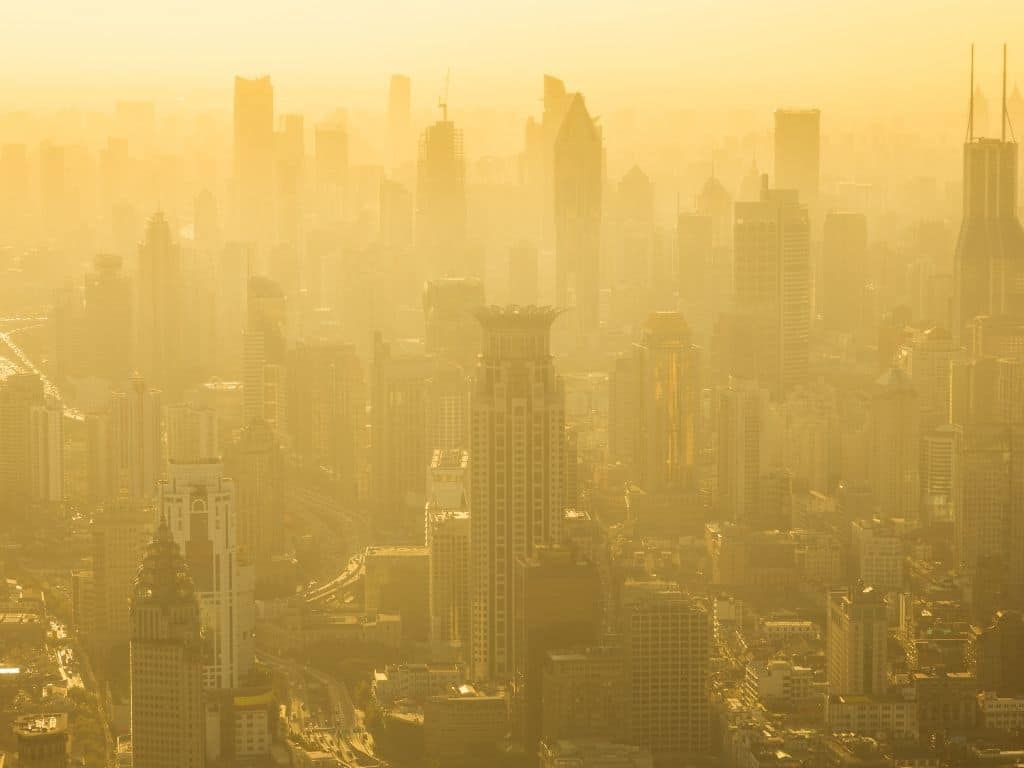Air pollution is the worst pollution-related epidemic in the world, responsible for the death of at least seven million people every year. Constant exposure to polluted environments substantially increases the risks of developing health issues and premature death. This ‘silent public health emergency’ – as the Head of the World Health Organisation defined it – needs to be addressed before it becomes irreversible. We take a look at the history of air pollution to understand how we got to such a dramatic situation and if this major environmental threat can be stopped.
—
The Industrial Revolution and Its Effects on Air Quality
Between 1820 and 1840, Great Britain and other European countries, along with the United States, began a transition to new manufacturing processes known as the Industrial Revolution. This process included the rise of the mechanised factory system to replace hand production methods, chemical manufacturing, iron production, and an increase in the use of steam and water power, all of which implicated the need for more natural resources such as coal and iron.
Industrialisation has created massive consequences for the environment, affecting first and foremost the air quality in developing urban areas. The expansion of factories and the rise in coal consumption and combustion gave rise to unprecedented levels of air pollution due to the dramatic increase in emissions of primary pollutants. The growing population also played a role, with private households substantially contributing to an increase in domestic emissions from burning coal for heating and cooking. The amount of pollutants in the air first increased in cities but later spread across countries. It quickly became a much larger-scale issue when global trade took off, turning air pollution into one of the harshest consequences of industrial growth across the world.
Europe and North America – the continents that first experienced rapid industrial growth – were not surprisingly also the ones most impacted by emissions and, for most of the second half of the twentieth century, they suffered the majority of adverse effects of air pollution. Until 1970, both continents combined were responsible for more than 80% of the global sulphur dioxide (SO2) emissions.
You might also like: 15 Most Polluted Cities in the World
4 Signs of Deteriorating Air Quality in the 20th Century
Until the 1980s, the most investigated environmental factors related to deteriorating air quality dealt with scientific discoveries of how air pollution impacted rain, ecosystems, and the ozone layer. We take a look at major events that shaped the history of air pollution in the last century.
1. The Great Smog of London (1952)
In December 1952, London was affected by one of the most severe events related to air pollution in the city’s history: the so-called Great Smog of London. For four days, the UK’s capital was covered in a thick layer of lethal smog, as airborne pollutants arising mostly from coal combustion accumulated in the air. The event was responsible for the premature death of an estimated 12,000 people. Apart from directly killing as many as 4,000 people, the smog made more than 100,000 ill, contributing to a steep rise in respiratory infections.
This environmental disaster led to the adoption of the Clean Air Act four years later, passed with the aim of tackling air pollution arising from industrial activities. The Act was a very important step and led to significant reductions in emissions in urban areas as well as to the closure of many urban power stations and other polluting industrial infrastructure.
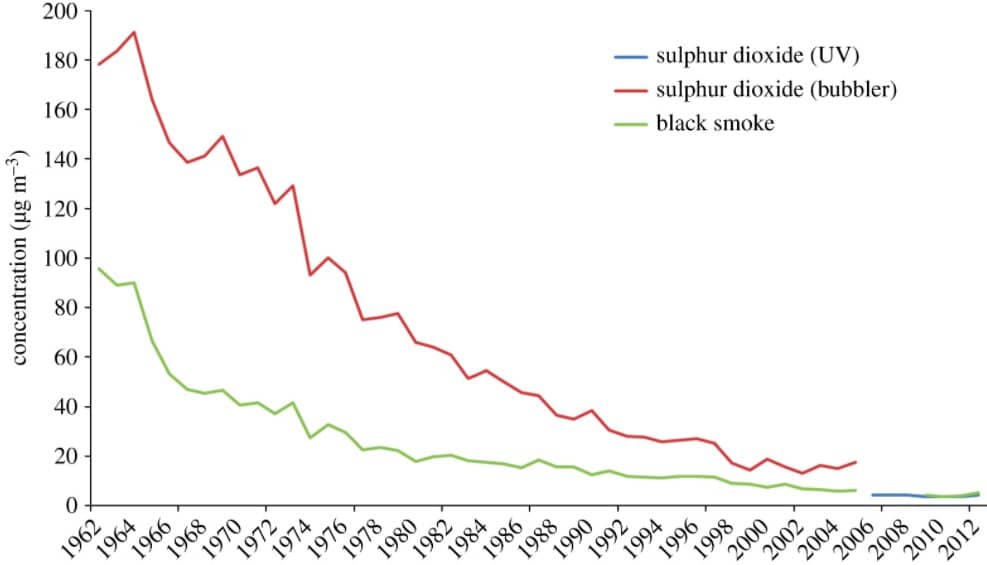
2. Acid Rain
First identified in North America in the 1960s, acid rain became the number one air-related issue. It was quickly classified as a direct consequence of air pollution that affected the environment, corroding surfaces, increasing the acidification of freshwaters, and contributing to the overall loss of biodiversity – mainly aquatic animal species. Between the 1960s and 1970s, this phenomenon became one of the most pressing environmental problems in Europe and North America. As scientists began investigating the causes of acid rain, they found a clear link between this phenomenon and the long-range transport of pollutants such as sulphur (SO2) and nitrogen oxide (NOx) from power plants located in some of the world’s major emitting countries.
Once the dangerous effects of acid rain were discovered, many countries stepped up their efforts in reducing emissions of these two pollutants, instituting an international framework – the 1979 Convention on Long-range Transboundary Air Pollution (LRTAP). The agreement required extensive monitoring of emissions as well as a plan for interpretation of the data and concrete action. In the following years, several acid rain-related policies were also passed. The most influential was the 1990 Clean Air Act Amendments. It established the US Acid Rain Program, aimed at setting targets to reduce emissions and implement policies to achieve it in two phases starting in 1995 and 2000 respectively. Nationwide, emissions dropped significantly: the US recorded an annual reduction in SO2 of over 93%, while NOx decreased by over 87% annually.
3. Deforestation and the Eutrophication of Ecosystems by Nitrogen Deposition
In the 1980s, another effect of air pollution became evident. Experts began noticing accelerated forest loss across several European countries, especially in the Czech Republic, Poland, and Germany. The deteriorating health of forests suddenly became a primary concern for the scientific community, who started noticing a link between the worsening air quality and deforestation.
Furthermore, as experts were developing an increased understanding of air contamination issues, a more dangerous pollutant than sulphur, nitrogen oxide, came under scrutiny. About 95% of NOx comes from human activities like the burning of coal, gasoline, and oil in vehicles, homes, industries, and power plants. The Netherlands and the UK were the first countries to observe abnormal changes in botanical species composition of heathlands. Eutrophication, a phenomenon responsible for the reduction in species richness of grasslands due to high concentrations of phosphorus and nitrogen in bodies of water, was soon discovered to be another consequence of air pollution emissions that affected ecosystems not only across European regions but also in North America and China.
4. Ground-level Ozone
One last event worth mentioning when revisiting the history of air pollution over the last century is ground-level ozone, another highly polluting gas discovered in the second half of the 20th century. Classified as a “secondary” pollutant as it is the product of two primary pollutants – nitrogen oxide and volatile organic compounds – this gas forms above the Earth’s surface and it is extremely threatening to human health. For this reason, it was listed in the aforementioned Clean Air Act along with other six air pollutants. Ground-level ozone was quickly associated with premature mortality and a range of health issues and diseases of the respiratory tract and it was found to also affect sensitive vegetation and ecosystems including forests.
A Shift Towards China and the Asia-Pacific region
After learning about the threats of air pollution to humans and the environment, both Europe and North America – the countries most affected by this phenomenon throughout the 20th century – took important steps in controlling and reducing their emissions of sulphur and nitrogen oxide. Meanwhile, other regions of the world have started their own Industrial Revolutions.
Until the early 1970s, Asia was the poorest continent in the world. However, in the second half of the 20th century, it experienced a profound economic transformation that led several Asian countries to become global economic leaders. Today, the entire continent accounts for nearly 40% of the global economy. Asia’s rapid and unprecedented economic growth of nearly 6% a year for the past 25 years, contributed to a shift from North America and Europe, which dominated global emissions until the early 1980s, to Central, East, and South Asia. The population growth that gave rise to some of the world’s largest ‘megacities’ and the rapid economic expansion of these regions led to a surge in oil and coal, which quickly became the biggest sources of fuel. Meanwhile, countries like India and Pakistan also underwent huge industrialisation and urbanisation, which eventually turned them into the world’s worst countries for air quality.
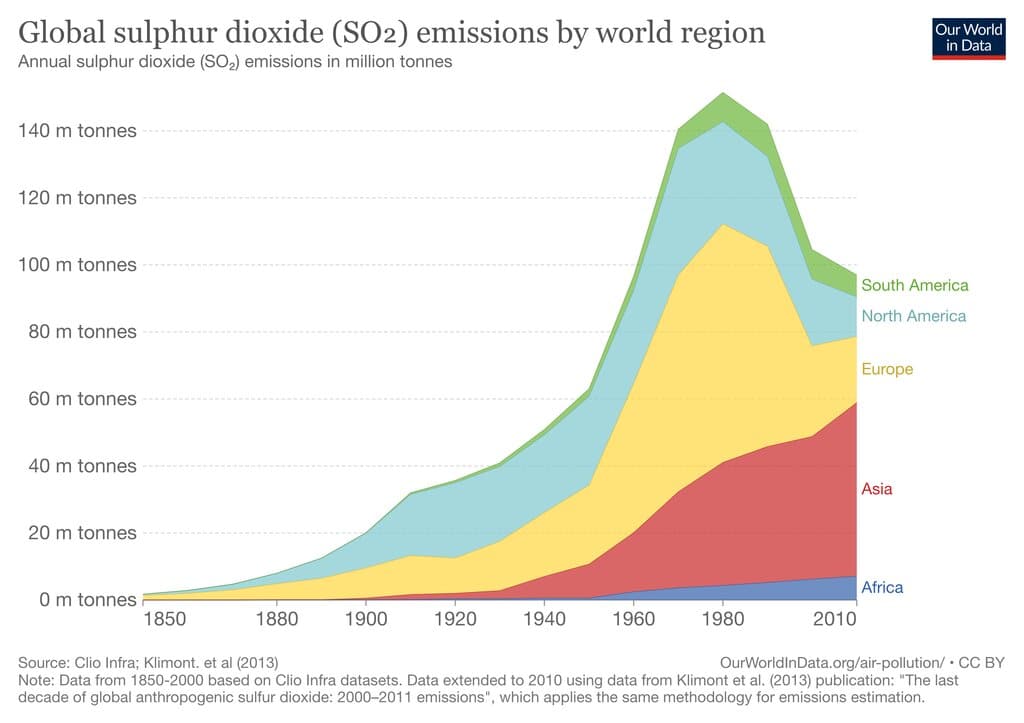
In the same years, advances were made in the detection of emissions and scientists developed a better understanding of some of the issues related to air pollution. At the beginning of the 21st century, new measurements, satellite remote sensing – which provided global data on primary and secondary pollutants distribution, and new epidemiological evidence brought the effects of air pollution on human health to the top of political agendas worldwide. Despite a 90% decline in SO2 emissions in Europe and North America from their peak in the 1970s, new pollutants that are responsible for millions of premature deaths and health issues worldwide have been discovered since.
You might also like: 13 Biggest Environmental Problems Of 2023
Air Pollution Today
According to the World Health Organization (WHO), 91% of the world’s population is currently living in places where air pollution levels exceed the Organizations guideline limits.
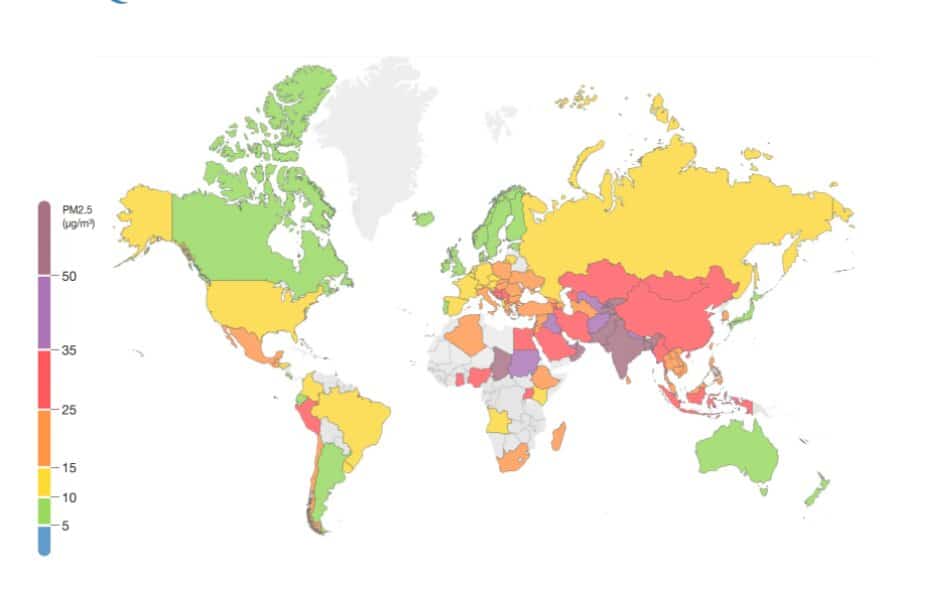
Effects of air pollution on humans overtook those on natural ecosystems in scientific research. Modern studies related to air quality now focus on a new pollutant, particulate matter (PM). The term refers to the sum of all solid and liquid particles suspended in the air of different sizes and it is considered the main contributor to human health effects by some margin. The most commonly used unit in air quality measurements is PM2.5 (see Figure 2), which refers to an atmospheric particulate matter that has a diameter of less than 2.5 micrometers (or about 3% the diameter of a human hair) and is said to pose the greatest risk to human health.
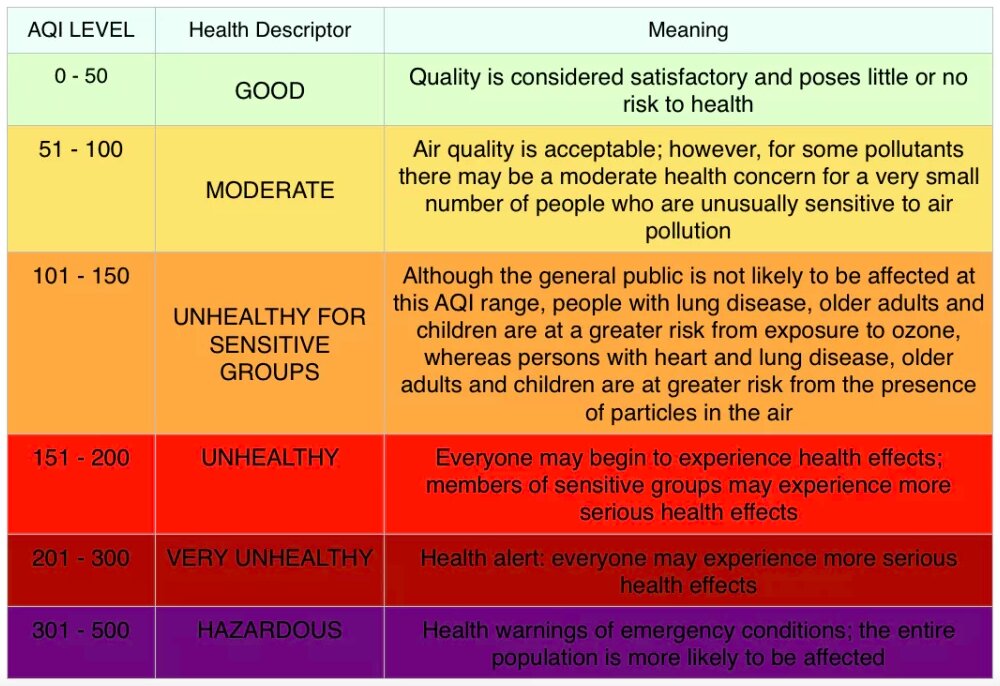
Contrary to the 20th century, the worst air quality in the world is found in the Global South, especially in developing countries in Africa, South America, and Southeast Asia. There are many reasons that explain this discrepancy. First and foremost, developing nations are rich in fossil fuels, and coal power plants remain prevalent in these regions. They also heavily rely on solid fuels that are responsible for severe indoor air pollution, such as wood, crop wastes, charcoal, and coal as well as kerosene for cooking, heating, and lighting. Furthermore, they lack technologies and economic resources to fight air pollution and its effects, such as adequate health systems to cure diseases related to this phenomenon. Finally, developing countries have weak laws and policies, such as less stringent vehicle emission standards than the ones of developed nations.
Six of the world’s 10 most polluted cities in 2021 were in India, with Bhiwadi topping the list with an average annual concentration of PM2.5 of 106.2. In the country, air pollution is the second biggest risk factor for disease and it costs the Indian economy nearly USD$150 billion dollars every year. 20-35% of its total urban PM2.5 concentrations are due to internal combustion engines in motor vehicles.
You might also like: 5 Effective Air Pollution Prevention Strategies
Future Outlook
Looking at the history of air pollution is important to understand how one of the most pressing environmental issues in the contemporary world came about. While history shows that countries have taken action before to stop the spread of certain chemicals believed to be the cause of air pollution, not enough has been done. Modern societies still rely on extremely polluting activities and energy sources, and air pollution is far from being a problem of the past. Instead, it still represents a colossal economic burden, which costs countries around the world USD$5 trillion every year. While we try to stop global warming and prevent climate change from irreversibly damaging our planet, we need to take more decisive actions such as closing polluting power plants while also reducing our dependence on fossil fuels and eventually relying completely on renewable energy. This also means shifting to cleaner transport means such as electric vehicles, improving industry and waste management in cities, building energy-efficient housing as well as investing in green power generation.
This story is funded by readers like you
Our non-profit newsroom provides climate coverage free of charge and advertising. Your one-off or monthly donations play a crucial role in supporting our operations, expanding our reach, and maintaining our editorial independence.
About EO | Mission Statement | Impact & Reach | Write for us








